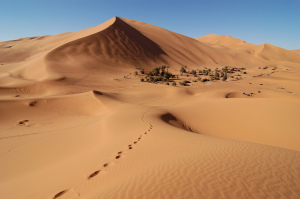Desert Sands: Moving dunes are a problematic natural hazard for builders in arid regions.
It was a thriving civilisation. Its people spoke and wrote an advanced language. They created elaborate works of art and developed a unique and beautiful style of pottery with which to ordain their magnificent palaces and temples. Their goods were traded far and wide in exchange for luxurious metals and wares and their impressive fortifications towered above a land of prosperous peace. Crops and herds were plentiful and gardens and flowers flourished. There was nothing to suggest imminent collapse. Yet in around 1600 BC the Minoan civilisation suddenly disappeared.
By piecing together written evidence, clues from Greek mythology, archaeological finds and analogies with more recent natural catastrophes, we now think that we know what happened. A massive volcanic eruption on the nearby island of Santorini, which is thought to have caused yellow mists as far away as China, buried a Minoan city in pumice and scattered ash across the fields, devastating local agriculture. A once mighty civilisation was abruptly humbled, and became an easy target, a few decades later, for Mycenean invaders to complete its demise.
The Minoan case has profound implications today. No matter how advanced our civilisation has become, and how safe we think we are, natural hazards can still cause unexpected devastation. Were a ‘supervolcano’ such as the Yellowstone Caldera in North America to erupt, the climatic impact of the smoke produced could spell the end of our entire civilisation, and we’d be powerless to stop it. Even today, we can’t predict when and in what way any volcano will erupt.
At least we know where volcanoes are, though. Earthquakes are yet more difficult to predict, though certain areas are of course particularly susceptible. According to theory, earthquakes occur when the stress built up when plates of Earth’s crust collide is suddenly released. This makes sense on plate boundaries, but it can’t explain why quakes also occur in the middle of plates, in places not previously hit. These places are usually unprepared for earthquakes, so when they strike population centres the loss of life can be catastrophic. For all our measurements with satellites and seismographs, the best we can do to predict earthquakes and volcanoes is to look at past activity and try to spot patterns or potential reoccurrences.
But natural hazards need not be catastrophic to be harmful. The precious monuments and buildings of our civilisation can be gradually worn away by weathering or damage from crawling plants unless careful monitoring and preservation work is carried out. In more arid climes, sand dunes can move across railways and roads and the very act of harvesting crops or grazing animals on vegetation can leave the soil so exposed to the winds that it’s billowed into toxic dust clouds during drought. To combat this, people have tried to dig out the dunes or replace the lost soil. But if we’re really going to protect lives and livelihoods from natural hazards, we have to accept that Earth is beyond our control and ability to predict.
There’s no avoiding the fact that we are part of a dynamic and sometimes dangerous world. We ought not to build across dunes or near volcanoes and sites of previous earthquakes, to strip semi-arid fields completely bare, or to tamper with our delicate climate. We ought to prepare existing settlements for natural hazards to strike anywhere unexpectedly, learning from the Minoan example. We have to work alongside and listen to nature, avoiding its hazards rather than struggling arrogantly and vainly to control them, if our civilisation isn’t to suffer the same fate as theirs.
![A Dangerous World Desert Sands: Moving dunes are a problematic natural hazard for builders in arid regions. It was a thriving civilisation. Its people spoke and wrote an advanced language. […]](/wp-content/uploads/2014/11/Dessert-sands-640x361.jpg)
